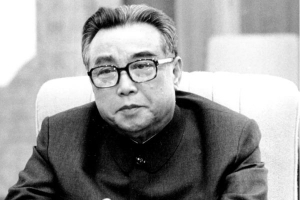Top 10 Interesting Facts about Busan
The main port city in South Korea is Busan, located in the southeast of the Korean Peninsula. Busan, with a population of about 3.5 million, is South Korea's ... read more...second-largest metropolis after Seoul. Busan is considered an administratively independent metropolitan area. While the suburbs are hilly, this central city is the most densely populated and is located in the small basin between the Nakdong and Suyeong rivers as well as the economic, cultural, and educational center of Southeast Korea. Busan is considered the busiest seaport in Korea and one of the five busiest seaports in the world is the Port of Busan. This "Southeast Economic Zone" surrounds the city that is now Korea's largest industrial region. Therefore, today's Toplist would like to introduce to readers 10 interesting facts about Busan that you did not know.
-
The seaside town of Busan is a popular location for sunbathers because of its extensive beaches. One of Korea's most well-liked beaches is the 1.5-kilometer-long Haeundae Beach, which is relaxed yet busy. A picturesque coastline with ideal swimming and relaxing conditions is created by the white sand beach's location in a small bay. Foodies should head straight for local specialties like king crab, and cold noodles, as well as street vendors selling fish sticks and steamed dumplings. Just a two-minute stroll from the charming Haeundae Beach, Shilla Stay Haeundae offers accommodations with panoramic ocean views. The building's architecture, which was influenced by the seaside city itself, is laid-back, residential-style with clean lines and gentle colors.
Busan has a lot of fresh seafood due to its proximity to the coast. Follow the locals to Jagalchi Market, Korea's largest seafood market, where you'll get the best deals. This market is sometimes likened to Tokyo's famous Tsukiji Market. Visitors will discover that a variety of raw and dried fish are prepared in a variety of ways and sold by usually female vendors, known as "Jagalchi Ajumma". In Korean, the word "Ajumma" means middle-aged or married woman. The street outside the market and the beach is lined with wooden boxes displaying mackerel, ascidians, and whale meat. The market, which has indoor and outdoor sections as well as seafood restaurants and buffets, is located on the road that runs along the beach in Jung-gu in the seaside town of Busan.
Haeundae Beach Vacation Travel Guide - Video: Expedia Jagalchi Market in Busan - Video: Strictly Dumpling -
Southeast Korea's economic, cultural, and educational hub is Busan. The Port of Busan is one of the five busiest seaports in the world and the busiest seaport in Korea as well as the largest transshipment port in northeast Asia.
As a small port with active trade between Korea, China, and Japan, Busan Port was founded in 1876. It is situated across from the Japanese island of Tsushima near the Nakdong River's mouth. Busan was one of the few locations which North Korea did not conquer during the Korean War (1950–1953), bringing war refugees to the city. In order to maintain a stable economy at the time, the port of Busan was crucial for receiving war supplies and help, such as clothing and processed meals. Factory workers moved to Busan in the 1970s as the footwear and chipboard industries grew, increasing the city's population from 1.8 million to 3 million.
Busan's port kept expanding, and in 2003 it ranked as the fourth-largest container port in the world. In 1970, South Korea represented 0.7 percent of world commerce; by 2003, that percentage had increased to 2.5 percent. Busan is the biggest container and general cargo port in the nation since 50% of the manufacturing employment there is tied to exports and 83% of the exports are containerized. Inchon port only handles 7% as many containers as Busan port does. Its rapid expansion is attributed to the Port of Busan's convenient accessibility from Singapore, Japan, and Hong Kong.
The port of Busan is now the tenth busiest port in Northeast Asia and the fifth busiest container port in the world. The 2004-founded Busan Port Authority (BPA) created, oversaw, and ran it. The four ports that make up the modern Busan Port are the North Port, South Port, Gamcheon Port, Dadaepo Port, International Passenger Terminal, and Gamman Container Terminal. With Gamcheon Port's assistance, the North Port can handle greater amounts of goods and offers passenger and freight handling services. The Busan Cooperative Fish Market, the biggest fish market in South Korea, is located in South Port and processes 30% of all marine catches. Dadaepo Port, which is west of Busan Port, specializes in the coastal catch.
Busan Port Authority - Video: Maritime Korea Mac-Net 4th largest container post in the world ranked in 2003 - Video: Uncle Jaiy TV -
This dynamic town celebrates music, dancing, culture, and art all year long because of its bright beaches and infrastructure designed for tourists (5,000 hotels serve only Haeundae Beach). Since Busan hosts at least one national event every month, tourists may swarm there to take part in the festivities. That is the reason why we say that Busan is a festival city.
Busan hosts many festivals all year round, including Busan International Rock Festival, Busan Port Festival, Busan Lotus Lantern Festival, Busan Fireworks Festival, Busan Sea Festival at Haeundae Beach (Korea's largest beach), and Global K-Pop Music Festival.
Since 2008, the Busan Port Festival has been held yearly to promote one of the world's top five ports—Busan Port—and to provide a range of activities that focus on the port's business, culture, and education. For guests who are in groups like families, friends, or couples, there are close to 30 organized events. The Busan Port Tour, in which guests board a ship to view North Port, is among the festival's standout attractions. The Embarkation Experience is a well-liked activity that showcases a navy vessel and a maritime police vessel, both of which are uncommon to witness. Busan Port Parade features an energetic performance and musical accompaniment, and Busan Port Stamp Tour allows visitors to explore a variety of exhibits and interactive activities at the National Maritime Museum and other festival venues.
Haeundae Beach Sand Festival - Video: Awesome Universe Busan port festival - Video: Quynh Ha -
In Jung-gu, Busan, South Korea, Yongdusan Park is home to the 120-meter-tall Busan Tower. Busan Tower was built in 1973 and is located in the middle of 16 popular attractions. The tower is just used for entertainment, unlike other towers in South Korea that are equipped with transmission machinery.
A modest cafe and a panoramic view may be found on the deck, which is only accessible during business hours via two high-speed elevators. Several galleries and gift stores link to the base of the tower. Tourist guides frequently recommend the tower as a nice location to see the city's harbor.
One of the Interesting Facts is that From the Top-Notch you can see the whole city of Busan. You can see Jagalchi Market, Gamcheon Culture Village, Yeongdaegyo Bridge, Haeundae, and many more cultural landmarks from the observatory on the fifth level. But be sure to explore the first two stories of Busan Tower before moving on. Tourists may discover the Trick Art Room, which has a 2D exhibit that will liven up your Instagram page, as well as the Projection Room, which showcases interactive media art. Tourists may also check out the Tag Live Wall, which presents a fascinating portion of Busan Tower's history.
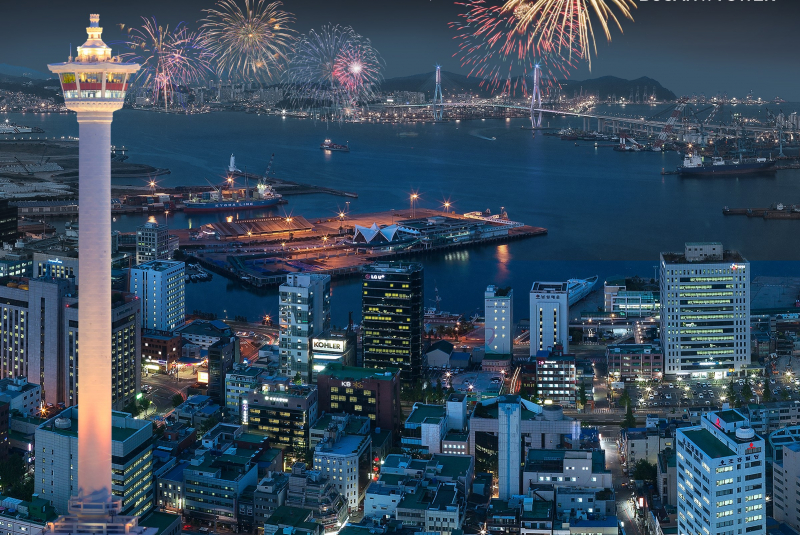
Busan Tower Observatory - Photo: KoreaTravelEasy Busan tower - Video: LIFE and ADVENTURE -
It seems sensible that the beach is the focus of Busan. It is nearly hard to see the sand through the bodies lining the shorelines throughout the summer, especially in August. Busan's resort-like atmosphere is a result of summer tourism, which concentrates on popular areas including Haeundae, Gujora, Sonjeong, and Gwanggalli.
Actually, due to its six beaches, Busan is known as the summer capital of Korea and draws visitors from all over the world. Koreans throng Busan's stunning beaches every summer, the most well-known of which is Haeundae Beach, a location for opulent hotels and events. Along the beach and Grand Gwangan Bridge at Gwangalli Beach, there are cafés, pubs, and restaurants. Other beaches include Songdo Beach, which is south of the city's center, and Dadaepo Beach, which is on the city's western outskirts.
The largest aquarium in Korea, Busan Aquarium, and Yongdusan Art Gallery are all located in the 69,000 square meter Yongdusan Park. The park, a popular tourist attraction with year-round cultural events, hosts roughly 70 different tree types.
Dongnae-gu is a wealthy, historic neighborhood that has a long history of being a lively neighborhood. There are several hotels, restaurants, shopping centers, and bathhouses in the natural mineral spring region of Dongnae Oncheon. Local eateries are well known for serving traditional cuisine. A Confucius shrine in Busan, Trung Liet Tu, also serves as a monument to the troops who lost their lives fighting against the Japanese invading force in the late 16th century.
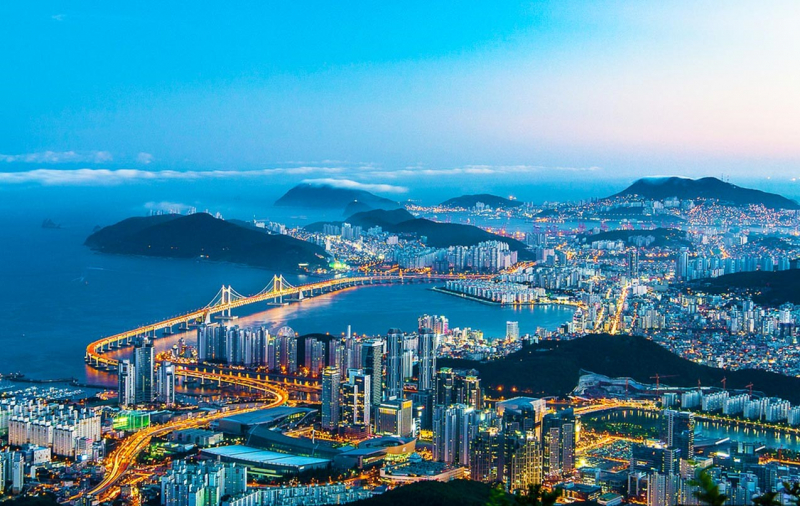
Busan's beaches: perfect places to enjoy summer - Photo: onedaykorea.com Summer days in Busan - Video: AmbasadaRoKSNS -
One of the 10 Interesting Facts is that Busan has the oldest hot springs in Korea. In Busan, taking a hot bath can help alleviate a variety of skin ailments as well as stress and exhaustion. Koreans have long liked taking hot spring baths, which is especially evident in the winter when locals fill practically all of the city's hot spring spas and saunas.
The majority of hot spring resorts in Busan are close to popular attractions and eateries and include the most modern spa and beauty amenities. Dongnae Spa is without a doubt the biggest and most well-liked hot spring facility in Busan. The aristocracy of the Silla Dynasty was said to enjoy Dongnae Oncheon Hot Springs the most, according to historical accounts. The high magnesium concentration and alkalinity of the spring water make it perfect for treating skin issues. According to legend, an elderly man with sore legs found the Oncheon Springs. He saw a crane that was hurt while taking a bath in a watery area. The crane flew away whole after taking its bath. The man's legs were also cured when he entered the same water that the crane had washed in.
This region was originally well-known for its hot springs before Haeundae Beach became quite well-liked. A hot spring foot spa is currently free to use for guests in the Haeundae neighborhood. The five-pool hot spring footbath overlooks the sea and is close to the Tourism Volunteer Center. You may observe hot spring water (at 43°C) erupting from the earth. A sunshade and a footbath for the handicapped are additional amenities.
The Hurshimchung hot spring is renowned for having Korea's highest magnesium concentration. The fact that this institution only uses hot spring water drawn from its own source makes it distinctive. Over 3000 people can stay in the enormous building's 40 functioning bathrooms. Visitors may also enjoy the spa and sauna facilities provided by hotels like Vesta Spa, Hotel Aqua Palace Spa, and Paradise Spa Hotel, to mention a few. Other well-known hot springs in Busan include those at Taejongdae and Songdo.
Hot Springs in Dongnae district, Busan city - Video: Đuc Nguyen Van 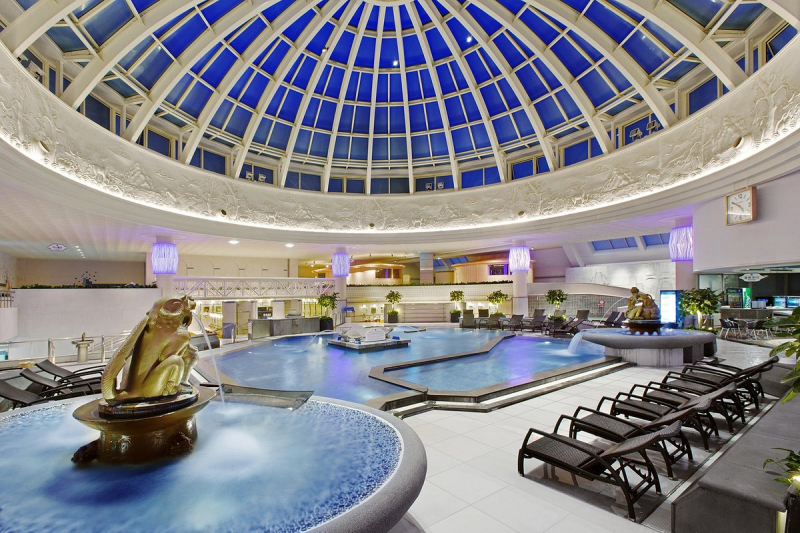
Hurshimchung hot srping - Photo: tripadvisor.com -
Busan is known as Asia's entertainment portal. One of the most important film festivals in Asia is the Busan International Film Festival, which takes place every year in Haeundae-gu, Busan, South Korea. The initial festival, which took place from September 13 to 21, 1996, was also Korea's first international film festival. The BIFF's primary goal is to spotlight new films and emerging filmmakers, particularly those from Asian nations. The festival's appeal to young people is another noteworthy aspect, as seen by the sizable number of young people it draws and its initiatives to nurture and promote emerging talent. Each fall, the Busan Cinema Center with a range of artworks from diverse sectors, and the Busan Biennale, an international contemporary art event held every two years, also draw many artists and tourists to this city.
Beginning in 2016, Busan will also host One Asia Event, the biggest K-pop festival in South Korea, solidifying its position as the hub of the genre.
The highest mural in Asia, "Portrait of a Fisherman" by German artist Hendrik Beikirch, was painted in 2012 on a structure close to Millak Raw Fish Town. There are 80 performance spaces in Busan, including 30 open ones such as the National Gugak Center, Busan Cultural Center, Busan Citizens, and Busan Cinema Center. There are 40 private enterprises, including the Kyungsung University Concert Hall, Sohyang Art Center, MBC Samjoo Art Room, and Shinsegae Store Culture Room.
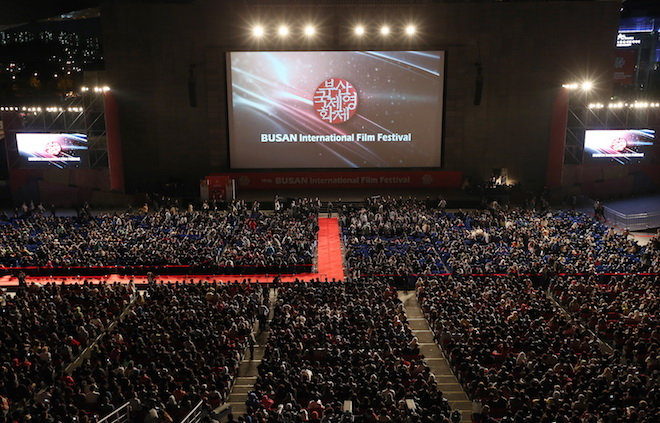
Busan International Film Festival - Photo: hapskorea.com 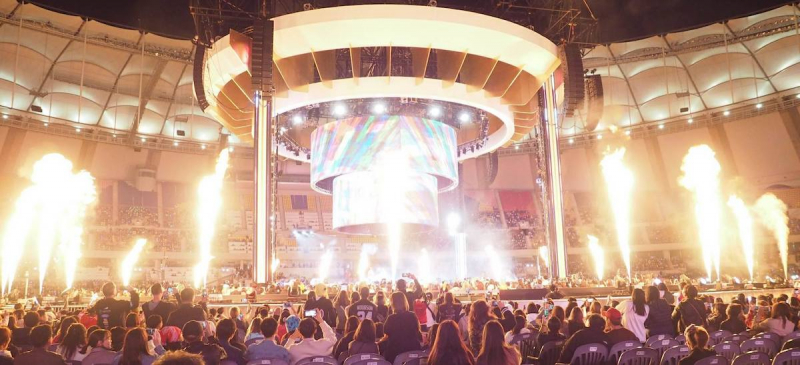
One Asia Event in Busan - Photo: hapskorea.com -
A special thing when tourists come to Busan is that Busan has the colorful village of Machu Picchu. In particular, during the Korean War, refugees constructed the popular tourist destination now known as Gamcheon Culture Village in Busan (1950-53). Gamcheon Cultural Village is known as the "Machu Picchu of Busan" because of its terraced buildings that are built on the slopes of coastal mountains. With paintings and sculptures made by the locals, the entire town is decorated in vivid hues.
This hillside town remained one of Busan's most impoverished areas for many years. Then, after the Ministry of Culture, Sports, and Tourism developed the "Dreaming of Machu Picchu in Busan" initiative to convert the hamlet into a creative and artistic location, everything changed for Gamcheon. As more artwork eventually began to adorn the little streets, homes, and stairs, more people began to visit.
Today, the hamlet receives over two million visitors annually. Gamcheon is made up of buildings that are constructed like staircases on the slopes of a coastal mountain. Most visitors to Gamcheon Cultural Village may participate in the hanbok show, where they can rent inexpensive costumes from various eras, including classic hanboks and enhanced hanboks. The highlight of the alley tour is the picture location where the tiny prince and the desert fox stare out over the settlement. Despite the lengthy lines, it's worthwhile to dress up in a lovely hanbok to get a wonderful picture. Try the photo booth at the lighthouse if you want to take a shot with a village backdrop.
A reinvented community on the hills of Gamcheon - Video: Alex Taseva / Алекс Тасева Machu Picchu - Video: Where's Anne -
The 2002 FIFA World Cup is the 17th FIFA World Cup, a world championship for men's national football teams organized by FIFA every four years. One of the first Asian locations to host players for this important international football competition was Busan. It was the first FIFA World Cup to be held outside of the Americas and the first to be split between two nations, Japan and South Korea, and it ran from May 31 to June 30, the same year.
FIFA chose South Korea and Japan as the 1996 World Cup hosts on May 31. Korea, Japan, and Mexico initially made three competing bids. Some people perceived South Korea's participation in the marathon as a reaction to its political and athletic rival Japan's warm welcome. FIFA's top executives disagree about who should prioritize hosting as the organization's internal politics deteriorate. South Korea and Japan won the competition to host the event since Mexico was considered to be a long chance. Co-hosting between the two Asian rivals is viewed by UEFA and the AFC as the ideal scenario. Ultimately, South Korea and Japan had to decide whether to co-host the World Cup or not, and they did so reluctantly. Ultimately, South Korea and Japan had to decide whether to co-host the World Cup or not, and they did so reluctantly. Mexico was rejected unanimously in favor of South Korea and Japan as co-hosts. The 2026 World Cup, which will be held by the United States, Mexico, and Canada, will be the second World Cup to be hosted by many nations after this one. The 2022 FIFA World Cup, which is going to take place, will be the second World Cup to be staged in Asia after this one. FIFA was eager in staging some matches in North Korea to help with the reunification of Korea, according to Song Young-Shik, general secretary of South Korea's bid committee, but was disqualified.
FIFA World Cup 2002 was held in Busan, specifically, at Busan Asiad Stadium.
Soccer is not the only significant international sport drawing attention to Busan. The BMW Ladies Championship is also being held in this booming metropolis. The only LPGA Tour course outside of the United States is the LPGA International Busan, according to official records.
Busan Asiad Stadium - Video: 이유이슈 이유사회적협동조합 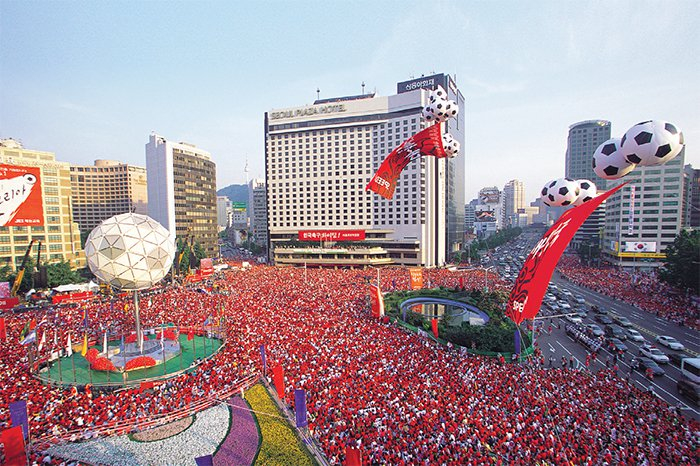
KCCUK 2002 FIFA World Cup Korea/Japan - Photo: kccuk.com -
A unique tomato from Busan is known as the Daejeon tomato. It was first grown in Daejeon-dong, Busan, thus the name. The Daejeon tomato, which is cultivated in this region and has a high sugar content, has a distinctive, salty flavor due to the area's saline soil and seaside setting. Given that it is listed as an agricultural product under the geographical indicator system, the tomato is well known for its worth.
Therefore, every year, the Daejeon Tomato Festival is held in Busan to highlight the excellent flavor of Daejeon tomatoes, which are cultivated on the rich soil along the Nakdong River. The goal of the Daejeon Tomato Festival is to showcase the excellence and fantastic flavor of Daejeon tomatoes, which have a fifty-year reputation for being of the highest quality and grown in the fertile soil of the Nakdong River delta. The festival also aims to promote regionally produced goods in order to revitalize the rural economy by broadening the distribution of food. It will promote community harmony and motivate farmers to continue working on the land.
On April 6 and 7, the yearly Daejeo Tomato Festival returns to Gangseo Sports Park. People have many opportunities to try delicacies prepared with tomatoes at this much-liked festival of regional production, as well as to purchase some of the wonderful red beauties at lower costs than normal. Free tastings, presentations of various tomato-based recipes, and the preparation of a huge plate of spaghetti are some of the festival's highlights.
Taste of 10 different Southeast Asian countries in the middle of Busan - Video: KOREA NOW 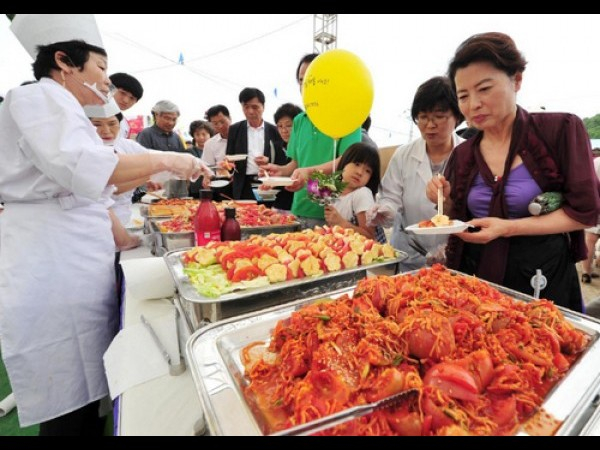
Busan Daejeo Tomato Festival - Photo: trippose.com





















